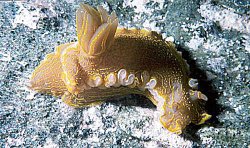 A nudibranch is a sea slug; "branch" means naked snail, it
is a suborder of molluscs. They are colourful molluscs lacking shells as
adults and having external respiratory appendages usually on the rear top
surface. These appendages on their backs are called cerata and are used to
get oxygen from the water. These appendages look much rather like feathers.
A nudibranch is a sea slug; "branch" means naked snail, it
is a suborder of molluscs. They are colourful molluscs lacking shells as
adults and having external respiratory appendages usually on the rear top
surface. These appendages on their backs are called cerata and are used to
get oxygen from the water. These appendages look much rather like feathers.
One of the foods that nudibranchs eat are anemones. From this food the nudibranch retains a chemical called nematocysts. Armed with these nematocysts, the colourful and highly visible nudibranchs are well protected from their predators.
They are one the most beautiful creatures in the ocean! There is over 3000 species worldwide, they are absolutely fascinating, and they make great photography subjects.
They are rare enough to command your attention when seen because they are, and I stress extremely difficult to find. They are however easy to follow once found.
When you see a variety you haven't seen you never know if it's one that has been taxonomically classified and given a species name, or one that nobody has had the opportunity to classify.
Most are very small, about 1-2 inches or less, though some species such as the Spanish dancer may grow up to 19 inches in length or more. If you search for them under rocks, you are more likely to encounter the smaller variety.
If looking for them you should slowly scan the reef from a very close distance (2-3 feet), you are more likely to encounter the well-disguised variety that utilises protective coloration to disguise itself against the background of the reef and algae.